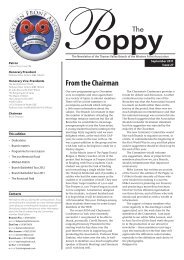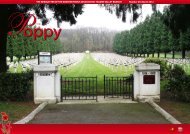The above group photo is of the staff - The Western Front Association
The above group photo is of the staff - The Western Front Association
The above group photo is of the staff - The Western Front Association
You also want an ePaper? Increase the reach of your titles
YUMPU automatically turns print PDFs into web optimized ePapers that Google loves.
encountered on th e Gu<strong>is</strong>eley Memorial.<br />
Finally Grant Smith presented a DVD<br />
which held <strong>the</strong> remin<strong>is</strong>cences <strong>of</strong> a local<br />
WW1 veteran.<br />
Kemmel Hill Rev<strong>is</strong>ited: November<br />
2011 (32 attended)<br />
Kemmel Hill, at over 150m, <strong>is</strong> <strong>the</strong><br />
highest point in <strong>the</strong> Ypres Salient and<br />
affords commanding views. It was taken<br />
on 25 April 1918 by <strong>the</strong> Germans during<br />
<strong>the</strong> Battle<br />
<strong>of</strong> <strong>the</strong> Lys,<br />
and<br />
recaptured<br />
by <strong>the</strong><br />
Allies in<br />
September<br />
1918. Jon<br />
Honeysett<br />
gave us an<br />
account <strong>of</strong><br />
<strong>the</strong><br />
involvement <strong>of</strong> h<strong>is</strong> fa<strong>the</strong>r - Charles<br />
Edward Honeysett - as an infantryman at<br />
Kemmel Hill using extracts from <strong>the</strong><br />
shorthand battlefield diary h<strong>is</strong> fa<strong>the</strong>r had<br />
kept - against regulations - during <strong>the</strong><br />
war. He also used recordings from an<br />
interview with h<strong>is</strong> fa<strong>the</strong>r in 1980.<br />
Charles was born in 1899, and we<br />
heard <strong>of</strong> h<strong>is</strong> Edwardian childhood in<br />
Croydon and h<strong>is</strong> willing enl<strong>is</strong>tment at<br />
Wimbledon Common in April 1917, on h<strong>is</strong><br />
18 th birthday. Charles spoke favourably <strong>of</strong><br />
h<strong>is</strong> training, including battle training on<br />
Sal<strong>is</strong>bury Plain.<br />
A spell <strong>of</strong> leave at Thornton Heath was<br />
d<strong>is</strong>turbed when <strong>the</strong> German Spring<br />
Offensive in 1918 led to Charles<br />
receiving a telegram on 27 March 1918;<br />
he was to report for embarkation to <strong>the</strong><br />
Continent. Thus it was that in early April<br />
1918 Charles found himself being<br />
inspected by General Plumer - who it<br />
seems was well liked by <strong>the</strong> men - before<br />
28<br />
being moved by motor lorry on 10 April to<br />
Kemmel in response to <strong>the</strong> German<br />
attack in <strong>the</strong> Salient <strong>the</strong> previous day. On<br />
11 April Charles was in waterlogged<br />
trenches on Messines Ridge, and soon<br />
came underfire.<br />
We heard fascinating audio<br />
recollections about h<strong>is</strong> chit chat with h<strong>is</strong><br />
comrades about <strong>the</strong>ir prospects; <strong>the</strong><br />
experience <strong>of</strong> being under artillery<br />
barrage and machine gun fire; rest<br />
periods with h<strong>is</strong> colleagues in <strong>the</strong> Royal<br />
Ir<strong>is</strong>h Fusiliers, with whom he felt at home<br />
and who were in fact quite a mixed<br />
nationality bunch - including a fellow from<br />
Ceylon; and <strong>the</strong> emergence <strong>of</strong> a 'working<br />
class’ consciousness amongst <strong>the</strong> men.<br />
Messines Ridge and Passchendaele -<br />
taken by <strong>the</strong> allies in 1917 at such huge<br />
cost - fell; <strong>the</strong> allied defensive front<br />
shortened; and on 11 April Haig <strong>is</strong>sued<br />
h<strong>is</strong> ’Backs to <strong>the</strong> Wall’ message. <strong>The</strong><br />
French and Brit<strong>is</strong>h on Kemmel Hill -<br />
including Charles on 13 and 14 April -<br />
came under intense bombardment,<br />
including gas and aeroplane attack, and<br />
eventually <strong>the</strong> steadfast res<strong>is</strong>tance <strong>of</strong> <strong>the</strong><br />
- mainly French - defenders weakened,<br />
Kemmel Hill falling into <strong>the</strong> hands <strong>of</strong> <strong>the</strong><br />
German 56 div<strong>is</strong>ion on 25 April, at heavy<br />
cost to both sides. Charles’ unit sustained<br />
heavy losses. <strong>The</strong> German advance<br />
beyond Kemmel faltered and was<br />
stopped on 29 April.<br />
By <strong>the</strong>n Charles had reported sick on<br />
22 April with a foot wound and a skin<br />
condition, and was hospital<strong>is</strong>ed in<br />
Boulogne until June, returning on light<br />
duties in early July, only to be<br />
reprimanded for impertinence to an<br />
<strong>of</strong>ficer. He rejoined h<strong>is</strong> battalion on 23<br />
July, and was very glad to meet up with<br />
<strong>the</strong> newly arrived US troops, who began<br />
shelling Kemmel Hill. In an audio extract<br />
Charles also spoke highly <strong>of</strong> <strong>the</strong><br />
Australians, South Africans and <strong>the</strong>



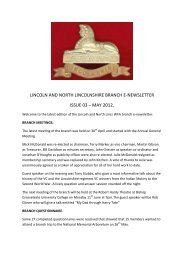
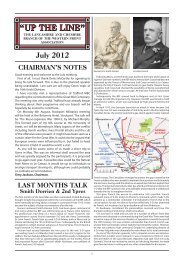
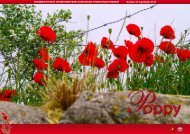
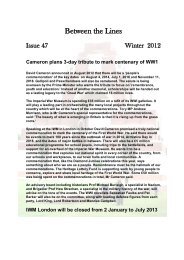
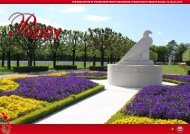
![Fromelles Australian Working List[1].pdf - The Western Front ...](https://img.yumpu.com/29972632/1/184x260/fromelles-australian-working-list1pdf-the-western-front-.jpg?quality=85)
